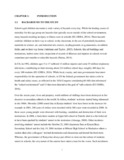Please use this identifier to cite or link to this item:
https://cris.library.msu.ac.zw//handle/11408/4042| Title: | Safety management in secondary schools in Bikita district.. | Authors: | Mando, Ernest K | Keywords: | safety management secondary schools |
Issue Date: | 2017 | Publisher: | Midlands State University | Abstract: | Over the recent years, numerous incidents of fire, accidents, injuries and abuses have been reported in many secondary schools in Bikita District with increasing frequency and severity. They include physical and psychosocial safety threats. However, there is no adequate documentation of all these cases. It was therefore necessary to make a study of safety management in secondary schools in the district. The main objective of this study was to examine the safety management system of secondary schools in Bikita District. A descriptive survey design was used in this study. The target population included the Secondary School Educators and the Learners. A cluster sampling and a quota sampling was used in the selection of secondary schools, ensuring that boarding schools and day schools were represented in the sample. A random stratified sampling was then used to choose students based on levels of education while convenience sampling was used on the educators. Data was collected using structured questionnaires for the educators and the learners to ensure authenticity, and an observation checklist. In other words, data collection techniques used included the questionnaire and participant observation. Microsoft Excel version 2010 was predominantly used in the analysis of data to yield frequencies and percentages. A regression analysis was applied to test the significant relationship between independent variable (type of school) and independent variable (management practices). Based on the findings of this study, it was observed that most secondary schools generally do not have safety management systems in place. All the components of safety management under the study that include management practices, systems and procedures, surveillance and maintenance had a relatively low positive frequency count that proves non-existence of safety management systems in schools. Most secondary schools do not have safety policies, safety personnel and safe operating procedures. Nevertheless, psychosocial aspects are relatively well addressed in most schools. The findings of this study will help the policy makers in the education sector to look into issues of safety and possibly incorporate this aspect into the national regulatory and legislative frameworks. This will ultimately reduce or eliminate physical and psychosocial safety threats in secondary schools. | URI: | http://hdl.handle.net/11408/4042 |
| Appears in Collections: | Master Of Science In Safety Health And Environmental Management Degree |
Files in This Item:
| File | Description | Size | Format | |
|---|---|---|---|---|
| MSHE DISSERATION FINAL DRAFT (Autosaved).pdf | Full Text | 1.33 MB | Adobe PDF |  View/Open |
Page view(s)
72
checked on Jul 26, 2024
Download(s)
62
checked on Jul 26, 2024
Google ScholarTM
Check
Items in MSUIR are protected by copyright, with all rights reserved, unless otherwise indicated.



